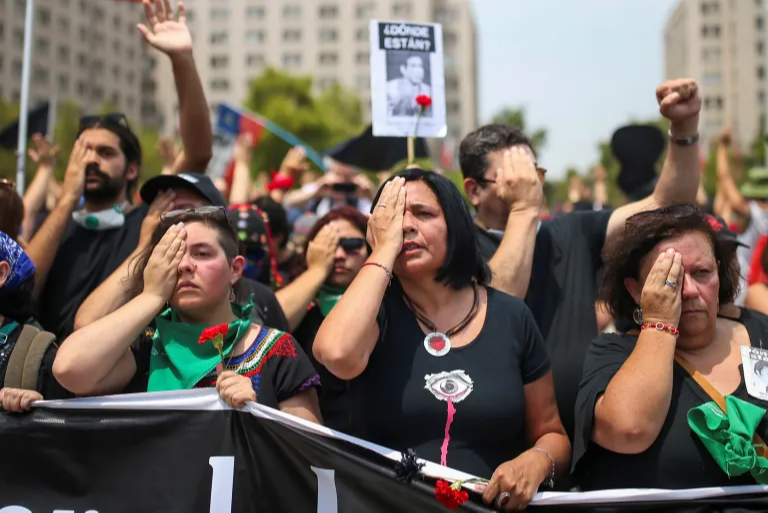
Women cover their eyes in reference to the protesters being blinded by rubber bullets and tear gas, during an antigovernment protest in Chile [File: Edgard Garrido/Reuters]
London, March 16 (RHC)-- Police misuse of rubber bullets and other less lethal weapons against peaceful protesters has killed dozens of people and maimed thousands in more than 30 countries over the last five years, Amnesty International has said.
The human rights group, in a new report published in London, said a global Torture-Free Trade treaty was needed to regulate the trade in policing equipment, including kinetic impact projectiles (KIPs) such as rubber-coated metal bullets, and to help protect the right to protest.
“We believe that legally-binding global controls on the manufacture and trade in less lethal weapons, including KIPs, along with effective guidelines on the use of force are urgently needed to combat an escalating cycle of abuses,” said Patrick Wilcken, Amnesty International’s researcher on military, security and policing issues.
Police misuse of such weapons, in addition to causing deaths, has resulted in an “alarming increase in eye injuries”, said the report, published jointly with the Omega Research Foundation and titled “My Eye Exploded”.
These injuries include eyeball ruptures, retinal detachments and the complete loss of sight, as well as bone and skull fractures, brain injuries, the rupture of internal organs and haemorrhaging, punctured hearts and lungs from broken ribs, damage to genitalia and psychological trauma.
For instance, in Chile, an evaluation by the country’s National Institute for Human Rights found that police actions during antigovernment protests in 2019 resulted in more than 440 eye injuries, with more than 30 cases of eye loss.
Among them was Gustavo Gatica, a 22-year-old psychology student, who was blinded in both eyes after being hit in the face by rubber-coated metal pellets fired by police during a protest in November 2019. “I felt the water running from my eyes … but it was blood,” Gatica told Amnesty. He said he hoped his injuries would inspire change and stop the same from happening to others. “I gave up my eyes so people would wake up,” he said.
Amnesty said the use of rubber bullets to suppress peaceful protest has also become commonplace in the United States. One demonstrator hit in the face in Minneapolis, Minnesota, on May 31, 2020, said his “eye exploded” from the impact of the rubber bullet, and his nose moved from where it should be to below the other eye.
The demonstrator, who underwent reconstructive surgery, added: “They put in a prosthetic eye — so I can only see out of my right eye now.”
In Palestine, Amnesty said Israeli forces have continued to routinely use rubber-coated metal bullets against Palestinians despite Israel’s Supreme Court recommending in 2000 that such weapons were lethal and should not be used for policing demonstrations. A recent report by the United Nations Human Rights Council documented 438 injuries among Palestinians due to Israel’s use of rubber-coated metal bullets during the Great March of Return protests of 2018.
Amnesty said it has also documented the use of tear gas grenades being aimed and fired directly at individuals or crowds in Chile, Colombia, Ecuador, France, Gaza, Guinea, Hong Kong, Iraq, Peru, Sudan and Tunisia.

